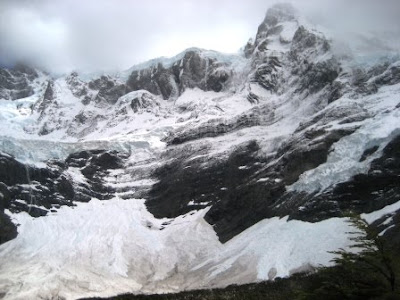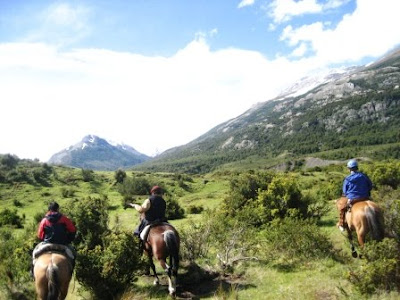In Patagonia

Glaciar Francés
I'd wanted to go to Patagonia ever since reading Bruce Chatwin's In Patagonia, and learning about giant sloth and the wild lands of the estancias. When our friend Catherine started recruiting people for a group trip, we eagerly jumped in, even though it would mean sharing our honeymoon with four other women.
To preserve some couple time, we ended up visiting an estancia and touring glaciers first, and then meeting the rest of the group half-way through their hike.
After flying into Punta Arenas, we visited tiny penguins, the cave where the giant sloth was found, and an estancia.
After flying into Punta Arenas, we visited tiny penguins, the cave where the giant sloth was found, and an estancia.
 Estancia Balmaceda -
Estancia Balmaceda -where Turismo 21 de Mayo took us horseback riding


A boat trip across a windy lake took us to the base of Glaciar Serrano...
 ... which is sadly receding because of climate change. The glacier used to flow right into the lake, but now has receded hundreds of meters up the cliff, leaving an exposed scar of raw, bare rock. Locals say that the glacier is receding 10-20 meters a year.
... which is sadly receding because of climate change. The glacier used to flow right into the lake, but now has receded hundreds of meters up the cliff, leaving an exposed scar of raw, bare rock. Locals say that the glacier is receding 10-20 meters a year. The effects of climate change are being felt the most at the high altitudes and latitudes. Though Chilean Patagonia is at sea level, it is quite close to Antarctica and the South Pole. At these extreme reaches of the Earth, climate is changing much faster than at the moderate latitudes. Average daily temperatures have increased more than 1.8 degrees Celsius (over 3 degrees Fahrenheit!) over the past century.
The effects of climate change are being felt the most at the high altitudes and latitudes. Though Chilean Patagonia is at sea level, it is quite close to Antarctica and the South Pole. At these extreme reaches of the Earth, climate is changing much faster than at the moderate latitudes. Average daily temperatures have increased more than 1.8 degrees Celsius (over 3 degrees Fahrenheit!) over the past century.The boat dropped us off at a small dock, where a Zodiac took us into Parque Nacional Bernardo O'Higgins, reachable only by boat.

Because of the cold and windy weather, and the near freezing water, we suited up like giant orange penguins for our ride in the open Zodiac. Even with all of our clothing (windpants over fleece pants and long underwear, fleece tops and down jackets), it was still cold in the Zodiac.

We walked to a lake at the foot of Glaciar Balmaceda,


and hopped into another boat to get a closer view of the serrated edge of the glacier.

After spending the night in a remote lodge, we rode the Zodiac up Rio Serrano into Torres del Paine National Park, where our friends were partway through their hike.

To reach the trailhead, though, we had to travel out of the park in a van, back to Punta Arenas - where we had a delicious Christmas eve dinner at one of the few open restaurants, and met Eric's law school buddy, who was serendipitously traveling in Patagonia with his Chilean wife and in-laws - before taking another bus, and a boat to the trailhead.
Crossing toward the Paine Grande, where we would rendezvous with the others, who'd already been on the trail for several days, we could see the (Cuernos) Horns of Paine in the distance.


Comments